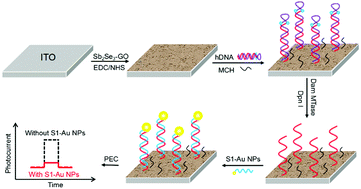Antimony selenide/graphene oxide composite for sensitive photoelectrochemical detection of DNA methyltransferase activity†
Abstract
Antimony selenide (Sb2Se3) as a p-type semiconductor material has recently attracted extensive attention for its excellent photoelectric properties in applications of thin film solar cells. However, applying Sb2Se3 as a photoelectrochemically (PEC) active material for constructing biosensors has never been reported. In this work, by using Sb2Se3/graphene oxide (Sb2Se3–GO) as both the PEC probe and substrate for biomolecule conjugation, a “signal-off” sandwich-type PEC biosensor was proposed for DNA methyltransferase (Dam MTase) activity detection based on gold nanoparticles (Au NPs) as quenchers. In the presence of Dam MTase and Dpn I, hairpin probe DNA (hDNA) was cleaved into single-stranded DNA (ssDNA), which could be hybridized with Au NP-functionalized DNA (S1) to form a double-stranded DNA (dsDNA) complex. The formation of dsDNA shortened the distance between Au NPs and Sb2Se3 on the electrode and induced competitive absorption and exciton energy transfer (EET) between Sb2Se3 and the Au NPs, thus significantly reducing the photocurrent. The constructed PEC biosensor exhibited a superior performance compared to most reports with a wide detection range from 1 mU mL−1 to 100 U mL−1 and a low detection limit of 0.6 mU mL−1 for the detection of Dam MTase. This work opens a new avenue for Sb2Se3 in biosensing applications and provides a new technology for the early warning and early diagnosis of diseases.



 Please wait while we load your content...
Please wait while we load your content...